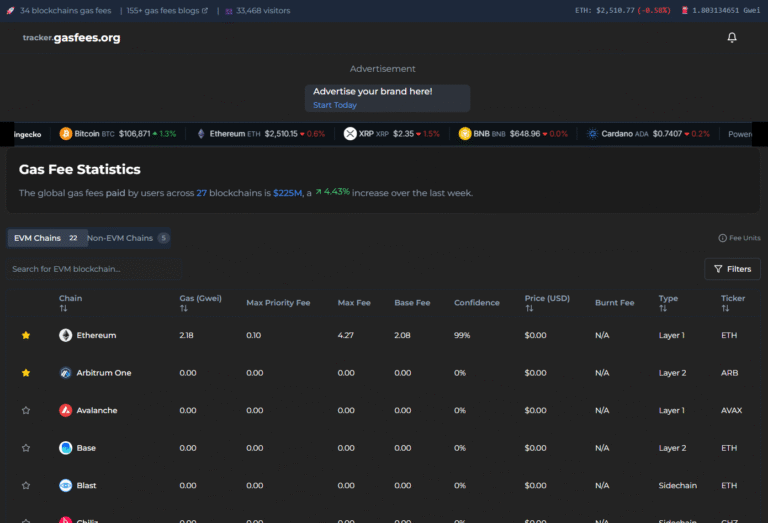What Are Klaytn Gas Fees?
For example, a simple KLAY transfer might use 21,000 gas, costing a fraction of a cent, while complex smart contract interactions, like DeFi swaps, incur higher fees. Klaytn’s low-cost structure—roughly 1/10th of Ethereum’s—makes it attractive for developers and users. Users can optimize fees by adjusting gas settings in wallets like Kaikas or using fee delegation programs, where third parties cover costs for specific DApps. Tools like Klaytn’s block explorer provide real-time fee estimates, helping users navigate this efficient, scalable network with ease.
In the ever-evolving world of blockchain technology, Klaytn has emerged as a prominent player. With its focus on user-friendly experiences and scalable infrastructure, Klaytn has gained recognition in the blockchain community. However, to truly understand the Klaytn ecosystem, one must delve into the concept of Klaytn gas fees. In this comprehensive guide, we will explore what Klaytn gas fees are, how they function, and their significance within the Klaytn network.
Unveiling Klaytn: A Quick Overview
Before we dive into the details of Klaytn gas fees, let’s take a moment to understand what Klaytn represents in the broader blockchain landscape.
Klaytn is a public blockchain platform designed for mass adoption. It aims to provide an accessible and user-friendly environment for developers and users to build and interact with blockchain-based applications. Klaytn’s unique features include its hybrid blockchain structure, which combines the benefits of both public and private blockchains, and its focus on empowering developers through developer-friendly tools and resources.
Deciphering Klaytn Gas Fees
In the world of blockchain technology, gas fees are transaction costs incurred by users to execute operations on the network. Klaytn is no exception to this fundamental concept. Klaytn gas fees play a pivotal role in the network’s operation, ensuring the security of transactions, the allocation of network resources, and the incentivization of network participants.
1. Resource Allocation
Klaytn gas fees are instrumental in the allocation of network resources. When users submit transactions or execute smart contracts, they attach gas fees as an incentive to validators to prioritize and process their operations efficiently. Higher gas fees typically result in faster transaction execution, ensuring that critical operations are handled promptly.
2. Network Security
Gas fees also play a crucial role in deterring malicious activities, such as spam attacks, on the Klaytn network. By imposing a cost on each transaction, Klaytn discourages bad actors from overwhelming the network with excessive or frivolous transactions, thereby ensuring the network’s security and integrity.
3. Validator Compensation
Validators on the Klaytn network, responsible for validating and confirming transactions, are compensated with a portion of the gas fees collected from transactions. This compensation incentivizes validators to participate in securing the network and maintaining its reliability.
Understanding Gas Fees on Klaytn
To navigate the world of Klaytn gas fees effectively, it’s essential to comprehend how these fees are determined and calculated. Several factors influence the cost of gas on Klaytn:
1. Gas Price
The gas price on Klaytn represents the fee users are willing to pay for each unit of gas consumed during a transaction or smart contract execution. Users have the flexibility to specify the gas price, allowing them to control the speed and cost of their operations. A higher gas price typically leads to faster transaction processing.
2. Gas Limit
The gas limit is the maximum amount of gas a user is willing to allocate for a particular transaction or smart contract execution. It serves as a safeguard against unexpected costs arising from complex or erroneous code execution. Users can set a gas limit to cap their potential expenditure.
3. Network Activity
Klaytn gas fees can fluctuate based on the level of network activity. During periods of high demand or congestion, gas fees may rise as users compete for limited network resources. Conversely, during quieter periods, fees may be lower.
Klaytn Gas Fees in Action
To gain a practical understanding of Klaytn gas fees, let’s explore some real-world scenarios where these fees come into play:
1. Token Transfers
One of the most common use cases on the Klaytn network involves token transfers. When users send KLAY (Klaytn’s native cryptocurrency) or other assets on the network, they incur gas fees. The fees can vary depending on factors like the gas price, gas limit, and network congestion.
2. Smart Contract Execution
Klaytn supports smart contracts, and executing them incurs gas fees. Developers and users interacting with smart contracts pay gas fees to compensate validators for processing the code execution.
3. Staking and Delegating
Klaytn offers staking and delegation services, allowing users to participate in consensus and governance. Staking and delegating KLAY tokens also involve gas fees, which can impact the overall rewards and incentives for users.
Strategies for Managing Klaytn Gas Fees
Efficiently managing Klaytn gas fees is essential to optimize your experience on the network. Here are some strategies to help you navigate gas fees effectively:
1. Gas Price Estimation
Utilize tools and wallets that provide gas price estimation. This allows you to gauge the appropriate gas price to achieve the desired transaction speed without overpaying.
2. Timing Transactions
Monitor network activity and gas prices. Timing your transactions during periods of lower demand can lead to cost savings, especially for non-urgent operations.
3. Choose Efficient Contracts
When developing or interacting with smart contracts, consider their complexity and resource requirements. Opt for efficient contracts to minimize gas fees.
Conclusion
Klaytn gas fees are an integral part of the Klaytn network, ensuring efficient resource allocation, network security, and validator compensation. Understanding how these fees work empowers users, developers, and businesses to make informed decisions when participating in activities on the Klaytn network.
As the blockchain landscape continues to evolve, Klaytn stands as a user-friendly and scalable platform offering security and accessibility. By mastering Klaytn gas fees and employing effective strategies, you can harness the full potential of this innovative network while optimizing your costs.
Stay informed, explore Klaytn, and embrace the future of blockchain with confidence, knowing that you can navigate Klaytn gas fees with ease and efficiency.




